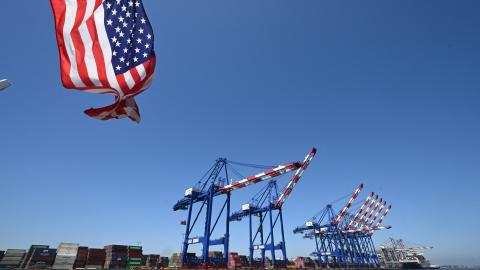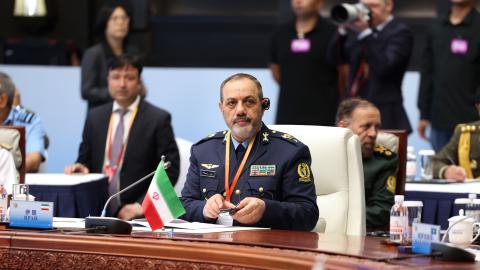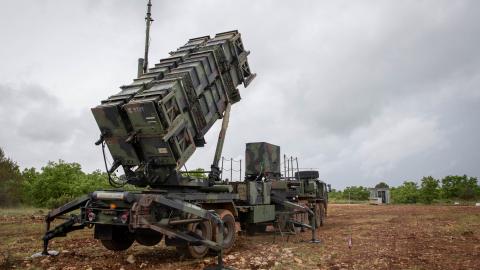Secretary of State Antony Blinken’s trip to Kazakhstan and Uzbekistan last week made him the first Cabinet level official to visit the region since 2020. Better late than never, but Blinken’s chief, even sole, aim—to nudge the five republics against aiding Russia in its full-scale war on Ukraine, or at the very least remain neutral—encapsulates the Biden administration’s failure of imagination and strategy in Central Asia.
It's not just the Biden administration. Blinken’s trip fits the pattern of US engagement with Central Asia since the fall of the Soviet Union. Policymakers approach these countries with short-term requests and to conduct crisis management while failing to institute durable, lasting ties and engagement. Though situated between top-tier American adversaries Russia, China, and Iran, Central Asia is a historical blind spot in US strategic thinking. But as Russia’s full-scale invasion of Ukraine enters its second year, US and allied policymakers are reminded of the costs of overlooking this pivotal region where major powers are tested and made.
When President Kassym-Jomart Tokayev of Kazakhstan, sitting on stage aside Vladimir Putin at the St. Petersburg International Economic Forum last summer, refused to support Russia’s sham independence referendums in the Donetsk and Luhansk republics of eastern Ukraine, a flurry of congratulatory headlines ensued throughout Western media. The feeling was that one of Russia’s historically closest allies had finally broken the mold.
Though as much as Tokayev understands Putin’s aims south of the border and looks to quietly free his nation from the Russian yoke, in fact thanking Blinken for the US support for Kazakhstan’s “independence, territorial integrity, and sovereignty,” now is not the time for the United States and its allies to take a victory lap and move on.
As Russian power recedes in the region, others—China in particular—will only happily fill the void. It’s in the American interest to present a counteroffer to the region, and it doesn’t appear that Blinken had any agenda to offer outside of pushing Kazakhstan, Uzbekistan, Kyrgyzstan, Tajikistan, and Turkmenistan to resist any Russian pressure to aid the war effort.
The C5 (Central Asian 5) have long sought increased trade and economic engagement with the United States, and the C5 foreign ministers frequently raised this point at the joint meeting in Astana. Economic freedom should be the centerpiece of a renewed US strategy in the region. In 2022, Russian trade turnover throughout the region accelerated, growing by 10 percent with Kazakhstan in the first ten months of the year, 40 percent with Uzbekistan in the first nine months, 22 percent with Tajikistan in the first eight months, 40 percent with Kyrgyzstan in the first six months, and 45 percent with Turkmenistan in the first quarter. China has also announced its intention to increase trade with Central Asia to $70 billion by 2030.
Meanwhile, Blinken presented $25 million in new funding to support economic growth. If this is the Biden administration taking an increase stake in the region and conveying the benefits of US cooperation in the wake of the economic reverberations in the region due to sanctions on Russia, as was a purported goal of the visit, then the initiative is doomed to fail. The administration would be wise to create a substantial economic and trade agenda for the region, in cooperation with partners and allies, that makes aligning with the US worthwhile.
Allies and partners, particularly the European Union and Turkey, should play an outsized role in this new economic agenda towards Central Asia. Both have been laying the groundwork. The EU, the largest foreign investor in Kazakhstan, agreed to bolster cooperation in trade, energy, and digital sectors with the country last fall. Turkey has also been busy signing agreements with Uzbekistan and Kazakhstan to boost economic and strategic ties and putting renewed energy into the Organization of Turkic States.
Nonetheless, as the foreign ministers made clear in this week’s meeting, the real increased economic engagement the region seeks is from Washington. And it would not just be of benefit to the Central Asian nations. The United States stands to benefit from access to the vast natural gas supplies in the Caspian, the rare earth elements in Kazakhstan, and Uzbekistan’s textiles industry (especially as cotton produced in Xinjiang was rightfully banned from US supply chains because of forced labor and the egregious human rights violations in the Chinese province).
Security must be another key pillar of US engagement in the region. While the US presence in Afghanistan generally kept the threat of terrorism to Central Asia at bay, the Central Asian countries watched the Biden administration’s precipitous withdrawal from Afghanistan with horror. A year and a half later, as Afghanistan becomes a breeding ground of global terror, Central Asian countries, particularly Tajikistan, have unique eyes into the country that would be an asset for US intelligence.
Renewed security cooperation between the United States and Central Asian states will take a great deal of shoe leather diplomacy, trust building, and bilateral engagement. This is again where devising a long-term strategy comes into play. The US needs to provide reassurance that our security partnership and cooperation is for the long haul.
Though the US trust in the region is deeply broken, it is not too late to repair. The best way to get started on this strategy is by simply showing up. An incumbent US president has never stepped foot in a Central Asian country. It took over two years into the Biden administration for a single Cabinet official to visit the region. The lack of US effort is noticed—and reciprocated—in these bilateral relationships. Blinken’s visit should be the first step in crafting a strategy towards Central Asia that advances the economic and security interests of America, the region, and the free world.

















![Secretary of State Antony J. Blinken visits the Khast-Imam in Tashkent, Uzbekistan, on March 1, 2023. [State Department photo by Chuck Kennedy/ Public Domain]](/sites/default/files/styles/16_9_sm/public/2023-03/03.06.2023%20Lee%20Coffey%20RCD.jpg?h=1c9b88c9&itok=EdJSFRyX)